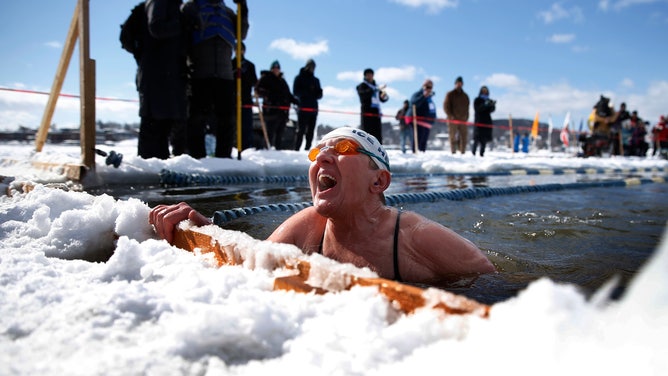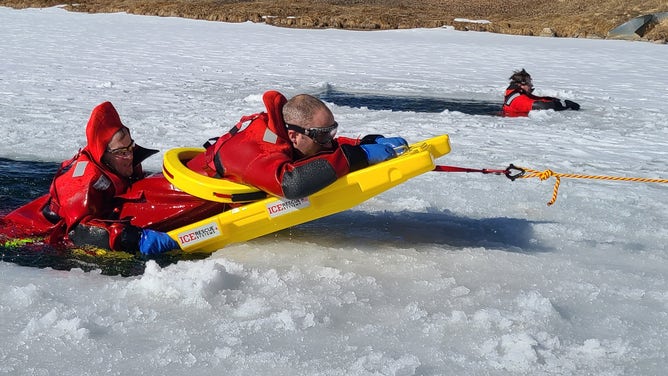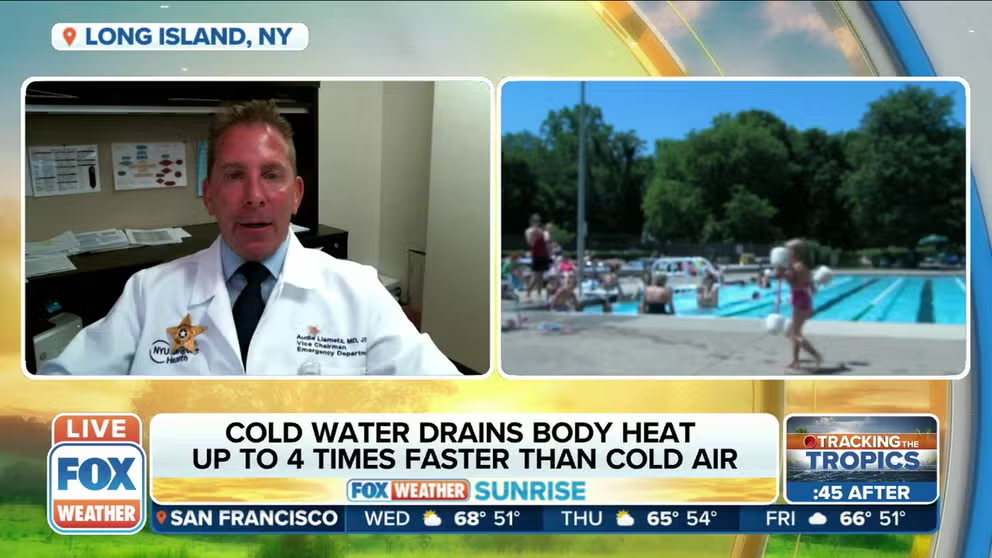Why hypothermia happens faster in cold water
People can get hypothermia even in a heatwave. Water temperatures of 55 degrees can be deadly, according to the National Weather Service.
Heat Wave Hypothermia: How diving into cool water could put you at risk
Audie Liametz, Vice Chairman of the Emergency Department at NYU Langone Hospital, explains how diving into cool water could put you at risk in the summer.
We can get hypothermia in the air when the temperature is 60 degrees, but cold water saps the body of heat much faster.
Hypothermia can happen in water as warm as 80 degrees, while water that is 64 degrees could be deadly, according to the University of Michigan.
"Immersion in cold water can become life-threatening very quickly," wrote the NWS office in Burlington, Vermont. "Since water conducts body heat away up to 25 times faster than air of the same temperature, the cold water rapidly causes extremities to become numb, weakens the ability of muscles to work effectively and eventually leads to hypothermia."
The U.S. Search and Rescue Task Force reported that cold water can rob the body of heat up to 32 times faster than air.
WHAT ARE COLD-STUNNED SEA TURTLES?

File: Even swimmers that have cold water training must exit the lake in this Vermont Festival swim meet after 5 minutes.
(Jessica Rinaldi / The Boston Globe / Getty Images)
It doesn't necessarily mean that just people falling through ice are in danger. Even during a heatwave, water temperatures can be chilly.
Cold shock
The first danger of cool water is "cold shock."
Cold shock can be just as severe and dangerous from water temperatures of 50-60 degrees as it is from water at 35, according to the NWS.
Gasping for a breath or rapid breathing from sudden immersion can be triggered by water as warm as 77, according to the NWS.
"When your body hits cold water, ‘cold shock’ can cause dramatic changes in breathing, heart rate and blood pressure," wrote NOAA. "The sudden gasp and rapid breathing alone creates a greater risk of drowning even for confident swimmers in calm waters. In rougher open water, this danger increases."
AT LEAST 6 MISSING AS UNDERWATER SEARCH CONTINUES AFTER BALTIMORE BRIDGE COLLAPSE

File: Colorado crews practicing cold water rescues when minutes matter.
(Evergreen Fire and Rescue / FOX Weather)
Cold shock can cause panic, which impairs clear thinking and decision-making. It can also cause a sudden spike in heart rate and blood pressure, which can lead to a heart attack or stroke. Severe pain from the cold also clouds thinking.
While cold shock diminishes after the first 1-3 minutes of sudden immersion, the body continues to lose heat. Even a person who has been pulled out of the water can still lose body heat. Wet clothes increase the body's heat loss by five times over the general 2% of body heat lost to the environment. Hypothermia, the body dropping to or below 95 degrees, comes in stages and degrees.

File: A cadet at the Royal Military College Duntroon in Australia succumbs to hypothermia in freezing temperatures and a wet uniform.
(NEWS LTD/AFP / Getty Images)
"So initially, you are in the water, and you start getting cold, and you start shivering, maybe develop slurred speech. You have some confusion, pulse may get a little weak," Audie Liametz, Vice Chariman of the NYU Lagone Hospital Emergency Department, told FOX Weather over the summer. "And then it can progress from mild hypothermia to moderate hypothermia, where you start having alteration in the mental status."
Mild, moderate and severe hypothermia
7 WAS TO STAY SAFE ON ICE AND WHAT TO DO IF YOU FALL THROUGH
Coordinated hand and finger movements can cease within minutes, which makes grabbing the edge of the water or a float for self-rescue difficult, according to the University of Minnesota Sea Grant, a water safety program.
"Swimming or treading water will greatly increase heat loss and can shorten survival time by more than 50%," warned USSARTF.
WHY 50 DEGREES FEELS FRIGID TO SOME BUT WARM TO OTHERS: THE SCIENCE OF ACCLIMATION
What is hypothermia?
Hypothermia often occurs at very cold temperatures, but you can still be susceptible at temperatures as warm as 60 degrees.
As hypothermia progresses, it strips the body of its automatic responses to combating cold.
"When it gets to very severe hypothermia, you can actually lose the shivering response," Liametz said. "Because the shivering response is the body's reaction to keeping the temperature warm. It warms you up by contracting the muscles," Liametz continued.
The normal body temperature is 98.6 degrees. Shivering starts at 96.5. Amnesia can start at 94. Brain function declines when the body temperature is 91 degrees, with unconsciousness at 86 degrees. The heart and breathing slow at 84 degrees. The human heart can stop at 64 degrees, according to Sea Grant. USSARTF stated that death can happen when the body is 79 degrees.
Flotation devices can prevent drowning even if a person is unable to swim, allowing more time for rescue. A person can become incapacitated or unconscious in cold water in as little as 9 minutes without a life jacket. With a life jacket, that time rises to 15 minutes.
Surviving hypothermia
The U.S. Coast Guard listed the following steps to increase your chances for survival if you are experiencing hypothermia:
- Stay calm.
- Get out of the water as soon as possible or grab something to float on to keep body parts out of the water.
- Swim to safety if possible. If not, conserve energy and heat until help arrives.
Once out of the water:
- Call 911.
- Move the person to a warm place, remove wet clothing and dry the person.
- Give CPR if needed.
- Wrap blankets around the person's torso. Don't warm the extremities first, as that may lead to shock.
- Do not submerge the person in warm water or warm them too quickly, which leads to a danger of heart arrhythmia.

